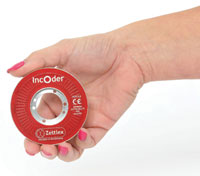
Posted to News on 23rd Nov 2014, 00:00
What's wrong with potentiometers?
Potentiometers have been around a long time and are still the most commonly used position sensor. So why does every design engineer seem to be looking for a non-contact alternative? Mark Howard of Zettlex examines this phenomenon and explains the pros and cons of potentiometers.

>There are more potentiometers sold than any other form of position sensor. They are simple to specify, inexpensive, widely available and compact. Laser trimmed potentiometers offer high accuracy measurement and, unlike their more complex, non-contact counterparts, there are practically no issues of long term component obsolescence. In terms of value for money, potentiometers are an excellent choice for many applications.
>Yet over the past 20 years there has been a massive swing towards non-contact position sensing. This has increased to such an extent that when potentiometers are proposed as part of a technical solution, there is a good chance of raised eyebrows, sucking of teeth and pointed questions about reliability and lifetime. So what's caused this, and is the swing to non-contact position sensing really justified?
>Clearly there are many applications where potentiometers will work perfectly well and offer trouble free operation over long periods. Consider a potentiometer measuring a linear displacement once every five minutes or so - the kind of typical application and duty cycle for a piece of factory automation equipment such as an actuator or valve. A good quality potentiometer might typically be rated for 500,000 cycles - that means it should be good for five years even with constant use 24 hours a day, seven days a week.
>It appears that all potentiometers have been classed as unreliable because of their susceptibility to failures in harsh environments. Now 'harsh environments' come in all sorts but there seems to be three particular issues that cause problems: vibration, foreign matter and extreme climates. Let us consider the previous application more closely, but in a vibrating environment such as a road vehicle, heavy plant or aircraft system. When we look closely at the displacement we can see that there are frequent 'micro displacements' caused by the vibration. At this microscopic level, the potentiometer's conductive track cannot differentiate between a full cycle and a vibration induced 'micro cycle'. Furthermore, because the potentiometer's wiper is at the same point for most of the time, the same part of the track is subject to most of the wear.
>Just like a pot hole (pun intended) in a road, a microscopic wear point on a potentiometer's tracks grows quickly, resulting in a discontinuity or 'flat spot' with no electrical response. Operation is severely, usually terminally, affected. Whereas 500,000 cycles previously equated to a lifetime of five years, in this example even at a modest vibration cycle of 1Hz, the lifetime reduces to less than ten days.
>Ingress of foreign matter can also be a cause of accelerated failure. Again at a microscopic level, the potentiometer's wiper should normally ride over the conductive track's molecular surface. When it's just the track and the wiper this works well. Introduce even tiny particulates between track and wiper and the effect is the same as an abrasive, rapidly accelerating the wear of the conductive track surface.
>Extreme environments per se are not a root cause of failure for potentiometers, but rather the generation of tiny micro climates in the immediate vicinity of the wiper and tracks. For example humid air, when cooled, may result in condensation on the wiper and ultimately cause corrosion or the condensation attracts and retains foreign particles.
>In summary, there are some applications where potentiometers will work well and there are others where they can prove unreliable. The unfortunate consequence of these high profile, harsh environment failures is that they have overshadowed the more benign applications where potentiometer operation has been reliable. This has led to a more widespread perception by engineers and technical buyers that potentiometers are the cheap, low quality option for position measurement.
>This widespread perception can put equipment manufacturers on the back foot when they are selling equipment that relies on potentiometers, since they are often forced to defend or justify the reliability and quality of their product. Consequently, many equipment builders are looking to replace potentiometers with non-contact solutions for marketing, rather than strictly technical, reasons. The unfortunate reality is that partially ill-founded market perception as a driving force for change is just as real and just as brutal as any technical reason.
>So why isn't everyone changing to non-contact? Well, the answer is that it's not straightforward. Firstly, there is the issue of cost. Most of industry still works from simplistic bill of material costings and these will always favour potentiometers over non-contact alternatives. It takes a more sophisticated cost analysis to include break-downs, warranty, spares, maintenance and service costs, to show that non-contact solutions are the less costly alternative for applications in harsh environments. Similarly, the sophistication required to show that product sales prices can be maintained when non-contact solutions are used, rather than a potentiometer, is usually beyond most hard-nosed industrial companies.
>Just as importantly, there is the knock on engineering caused by replacing potentiometers with a non-contact alternative. Non-contact devices tend to produce a digital electrical output whereas potentiometers produce a simple analogue output. Changing from analogue to digital will require the host electrical system to be re-engineered,
>re-tested and re-qualified. Similarly, potentiometers are compact and so the space previously occupied by a potentiometer will usually be too small or not quite the right shape for its non-contact alternative. Such a change may require a complete mechanical redesign and hence re-testing and re-qualification.
>Where potentiometers are being swapped for a non-contact alternative, a common replacement is one of the new generation inductive sensors (pictured top). These new sensors work in a similar way to traditional resolvers or linear transformers but are just as compact as a potentiometer. Rather than a traditional inductive sensor's wire spools, these new generation devices use printed, laminar windings to generate the inductive fields.
>These sensors can also generate a high accuracy voltage or current analogue output to mimic a potentiometer and hence avoid the need to re-engineer the host control system. They are well suited to harsh environments with operating temperatures between -55 to +230° Celsius and can be encapsulated for long term submersion or operation in explosive environments. Since they are lightweight and non-contact, vibration and shock have negligible effect.







